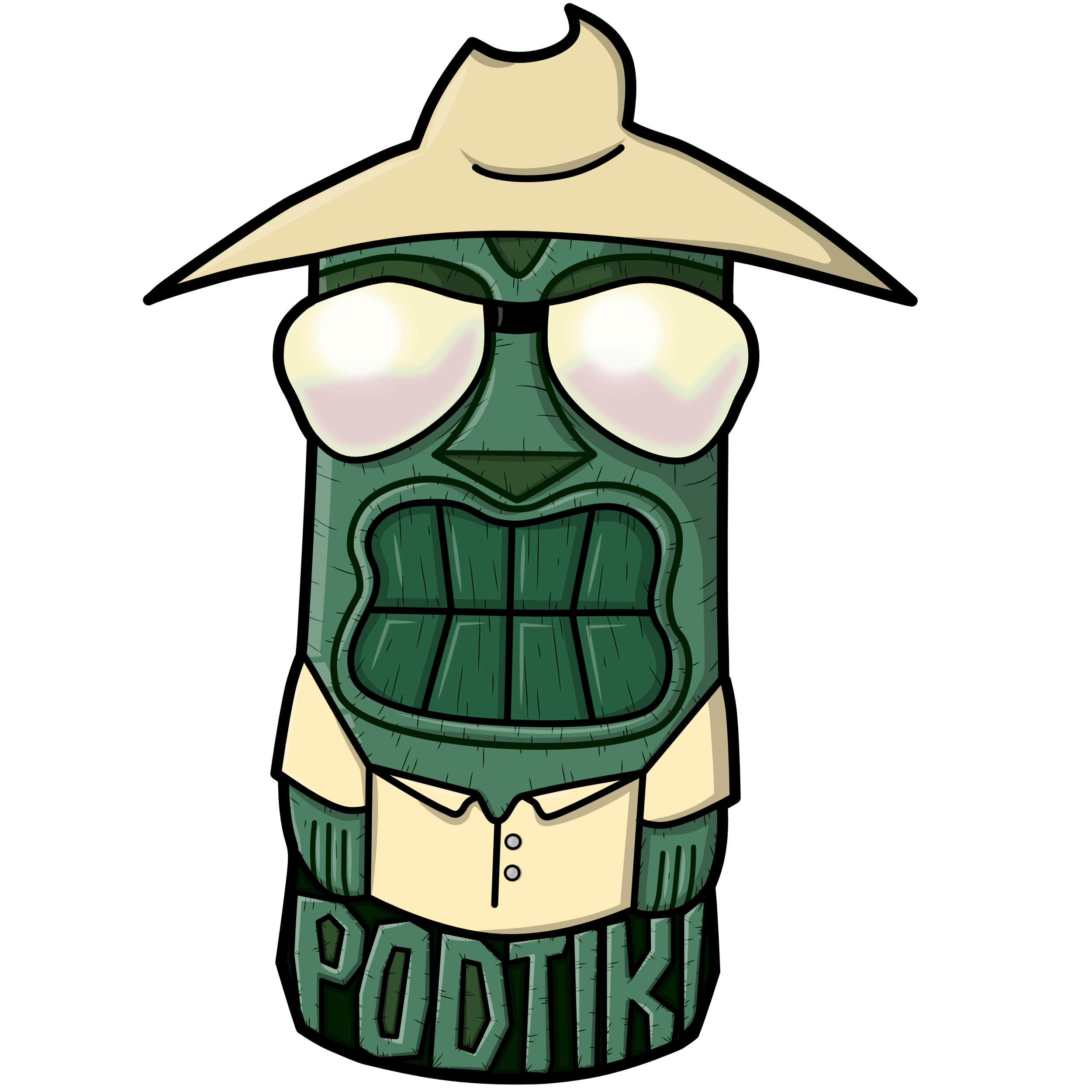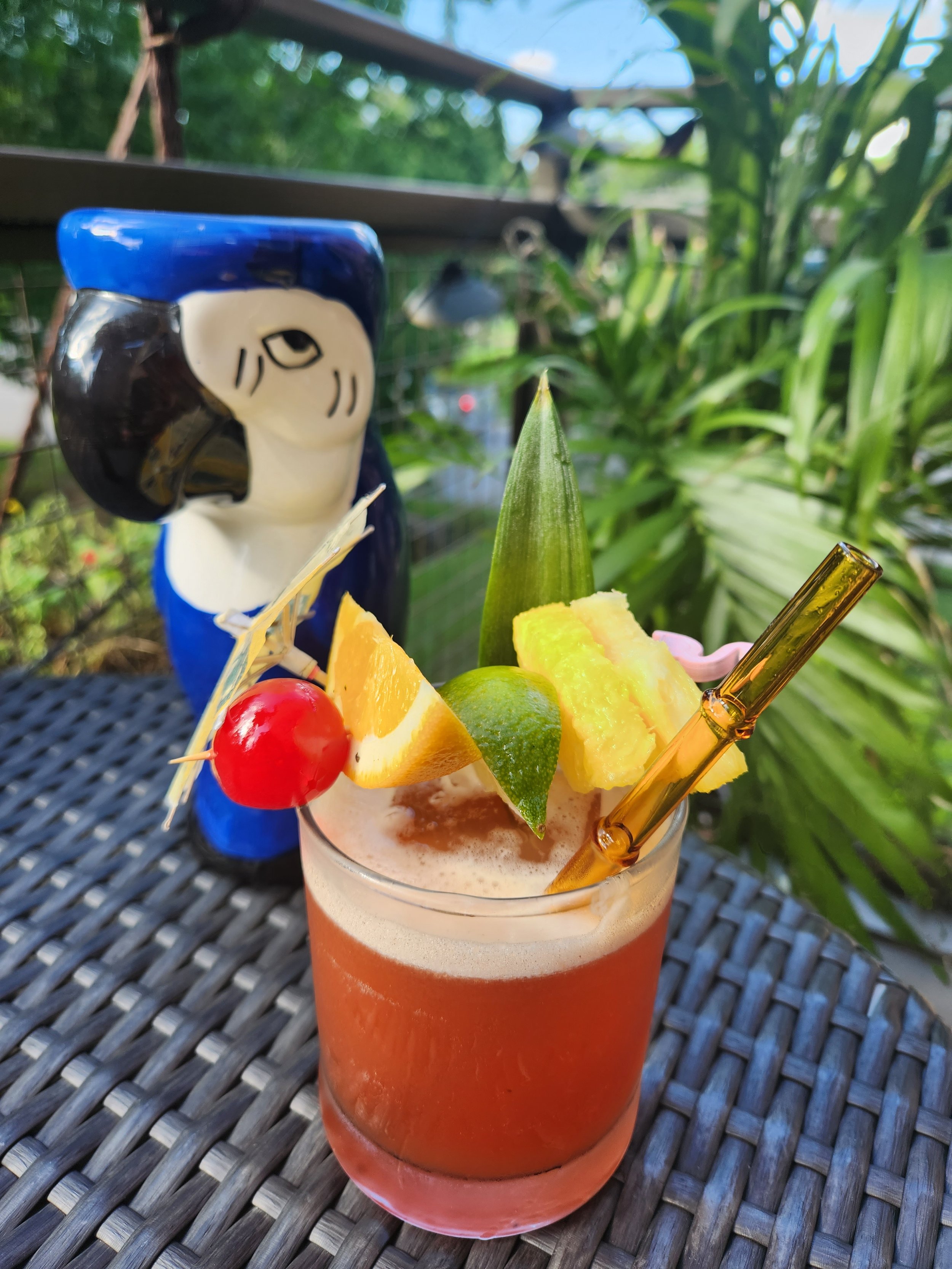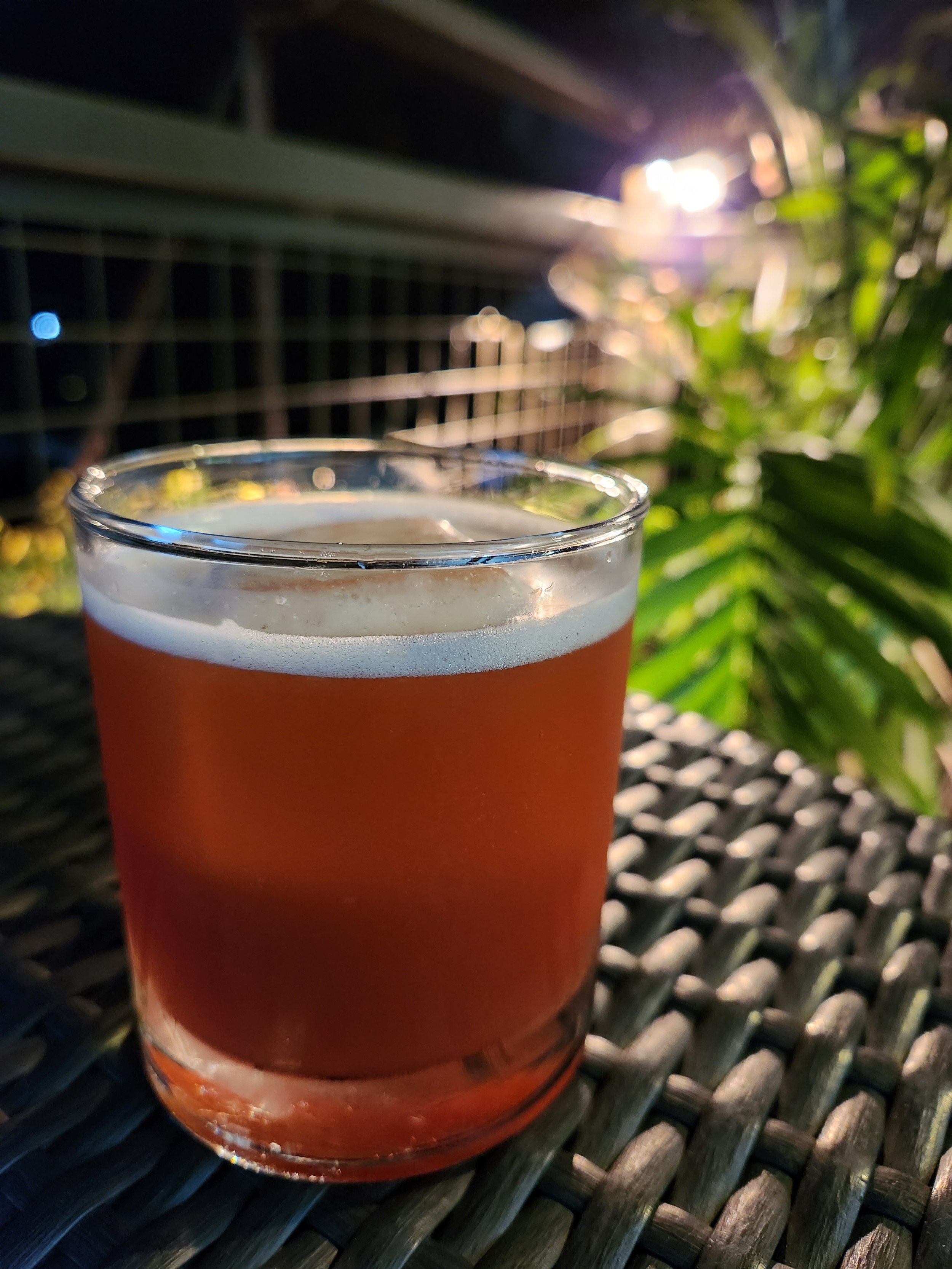Nashville, Tennessee is a booze town. That’s what people come here for. Whether it’s longneck bottles of light beer in a honky-tonk or finely crafted cocktails at a speakeasy. That’s one of the reasons it’s so easy to be into Tiki here. Most of the popular liquor stores cater to the craft cocktail enthusiast with esoteric liqueurs and large varieties of each spirit.
The bar menus in town support this by offering well crafted and cohesive programs. Everything from prohibition classics to modern Tiki is in effect. Even the “dive bars” have taken to mixing up some tropical options. Yet, notwithstanding this glorious milieu of cocktalia, sometimes you’re in the mood for a surprise. So, you let the bartender know you’re into Tiki and ask if he or she could make you something off menu. Chances are you’re going hear, “I got you, fam! This is sorta like a Jungle Bird.” Or, “Sure thing! Here’s my riff on a Jungle Bird.” Other times they just drop their head, look up from under their brow, and shrug out, “Jungle Bird?”
Ladies and gentlemen, my name is Tony, and this is Pod Tiki.
The fact that this seems to be the go-to anytime pressed for an off-menu tropical is not in any way a slight on the Jungle Bird. On the contrary. It shows how pervasive and transcendent this drink has become. But, why does the Jungle Bird seem to be the go-to tropical for so many bartenders. I think the reasons are threefold.
One: It’s easy. Any full liquor establishment will have the basic ingredients to make one even if it’s not a tropical bar. It doesn’t call for crazy syrups or specific brands. Two: It looks the part. When someone orders a tropical drink they expect it to appear tropical. With its scarlet hue, thin frothy head, and prodigious fruit garnish the Jungle Bird does just that. Last but definitely not least: It tastes good. Like most simple ingredient drinks, balanced construction is key. But, what’s unique about the Jungle Bird is that with a small tweak in either direction it can pander to the Tiki nerd or craft cocktail fan. (I know those two are not mutually exclusive, but when I say “craft cocktail”, I’m referring to the more classic, speakeasy style drinks.)
Another thing that stands out about the Jungle Bird is its provenance.
One of the delightfully enigmatic facets of Tiki is how many locales and cultures from which it sponges inspiration. Polysnesian decor underwritten by tastes of Caribbean spirits. But, like those two versions of paradise that so diligently languish about our American flanks, Tiki is truly an influential melting pot. South America, Africa, and yes, even the good ol’ US-of-A lend aspects of their respective cultures to the Tiki oeuvre. One of the most essential of these contributors though is Southeast Asia.
Trader Vic famously used Cantonese cuisine as the basis for his food menu, but it’s the tropical peninsulas and archipelagos of Southeast Asia that lend so much to the notion of exotica. Perhaps it seems more fascinating to an east coast tropics kid such as myself, more accustomed to Latin and African influences, but the impact of Asian culture on the Tiki scene is undeniable. Anything from artifacts, to flavors, to the famous fu-manchu mug. To say nothing of the fact that these are indeed tropical islands and jungles. The inextricable, and sometimes complicated, link between the U.S. and south-east Asia is on par with any Caribbean or Polynesian nations. Not the least of which is that we happen to have territories in all three geographies. But hey, what’s a tropical dot on the map between friends, right? Truly, I believe there is just an ineffable thread tying all the tropics of the world together. It’s a way of life that bonds equatorial people all around this wobbly rock we call home. It’s neither forced nor inherent. It just is. It can’t be gleaned over a 5 day vacation. And I consider myself lucky to have grown up tropical.
With so sundry a palate from which to paint the portrait of Tiki I’m glad that this particular cocktail, though begotten in Asia, utilizes a liqueur near and dear to my heart, finally blending my Italian heritage into a Tiki drink. There's actually a lot of Italian expats in the tropics. In fact, it was Italians and Cubans co-mingling in the cigar factories of Tampa that discovered Cuban roast pork on Italian bread makes a damn fine sandwich. Which evolved into the Cubano we know and love. But we’ll get to that later.
Meanwhile, we jump into the history portion of this episode where we travel to Malaysia. The Malay peninsula, stretching out from under Thailand, Cambodia and Viet Nam, was settled as a trading post by Chinese and Indian peoples around the first century AD. Ok, we’re not going that far back. Let’s jump ahead a thousand years or so to 1786 when the British East India Company leased Penang Island from the Sultan of Kedah. If you know anything about The Company, as it was called, you know that was all this highly corrupt giant conglomerate needed as permission to colonize the entire area. By 1900 the British Empire controlled the majority of Malay states either through direct rule or by certain British ambassadors that “advised” local leaders.
During WWII Japan invaded the Malay states and took control for a brief time before an Allied victory found the nations back under British rule. Through all of this changing of the guards the people of the Malay nations began thinking, “You know what would be cool? If maybe we just governed ourse---” Ohhh, the powers that be were having none of that. Till the city states of Malay finally caught a break in 1948 when autonomy was given to the Federation of Malaya. Under British protection of course. By 1963 they had collectively become Malaysia, sans Singapore, who decided to sling out on their own. I think they did alright considering the other famous drink from this part of the world is named after them.
Throughout the 20th century Malaysia was fraught with race riots, political strife, and economic turmoil. It was amid this tumult in the early 1970’s where we find ourselves where we so often do when tropical enterprise is concerned … a Hilton Hotel. This time in the south western city Kuala Lumpur.
One of the attractions at this location was the Aviary Bar. From the bar guests were able to look through a glass panel and watch tropical birds housed in a netted area by the pool. Hence, the Aviary. I’ve been to some pretty cool bar concepts, but this sounds pretty amazing. The closest thing to this I’ve experienced is Coconuts on the other side of Cozumel where actual parrots walked on the bar while we drank. It was a magical experience for a tropics nerd such as myself and as much as I can remember that’s the only time I’ve gotten drunk with a bird.
The Aviary Bar is still open in the Kuala Lumpur Hilton as of this recording and still boasts the avian theme. Sadly, from the pictures I’ve been able to find, the aviary window is no more. But if you know more about this please message and let me know.
Upon opening in 1973 the bar staff was tasked with creating a welcome drink. It was from among six proposed recipes that Jeffery Ong’s drink was selected and subsequently named to commemorate the birds. It was even served in a ceramic bird shaped glass, sipped from an opening in the tail.
Ong Swee Teik, a Penang native also known as Jeffrey, was the bar manager at the time. He only worked at the KL Hilton for 2 years before moving back to Penang. He continued mixing there for a time eventually leaving the bar scene for a career in purchasing at hotels. A position he happily worked till retirement. Unlike some of the other famous bartenders from this part of the world, like Dick Santiago or Hank Riddle, whose prolific profile of potables elevated them to Tiki royalty, Ong got in - created one of the most famous drinks in the world - dropped his bird shaped microphone - and got out.
Ong’s wife told thirstmag.com that he didn’t even drink. He would smell the ingredients to see what went together and only take a small sip of the finished product to confirm. He didn’t relish in the bar life and stopped simply because he didn’t want to work late once he had a family. Jeffrey Ong died peacefully in 2019 at the age of 71 in his hometown of Penang, but his contribution to cocktalia lives on every time someone walks into a bar and asks, “can you make me something kinda like a Tiki drink?”
So, in honor of Ong and all you birds of paradise out there - let’s make a drink!
Shall we begin with rum? We shall. A Kuala Lumpur training manual from 1982 calls simply for “dark rum”. Having no clue what the prevailing dark rums were in 1970’s & 80’s Malaysia this suggests it could have been any number of things. Is this referring to any aged rum? Or, perhaps a Jamaican darkened with added molasses? Or, a blackstrap? Martin Cate’s rum classification system suggests a “black blended rum”. I take umbrage because this places dark Jamaicans, like Myers’s and Coruba, in with Cruzan Blackstrap, which tastes wildly different. We finally get a modern definitive in 2002 when Jerry Berry publishes Intoxica!, where he specifically names dark Jamaican as the desired choice. I get that this category is such a ubiquitous fall back, but that’s because it works best with these type of tropical flavors. It may seem one sided as sipper, but placed in a cocktail the notes of dried dark fruit and rich burnt molasses begin to open up. Besides, it fits with this being a fall back cocktail.
A well aged rum like Appleton 12 is technically a dark Jamaican rum, and if you want to class up the joint - by all means, but following the spirit of the law here I feel pretty confident that your garden variety dark Jamaican “tiki” rum is what this is referring to. I attempted using a pot still rum, which is Shannon Mustipher’s recipe, but thought the signature pot still flavor overbearing. It created an unpleasant clash with Campari. This could be due to the fact that she suggest Hamilton Pot Still Black, which I cannot get here (p.s. If anyone had the hookup, let me know.), so I used Smith & Cross. Her version omits sugar which, and I can’t believe I’m saying this, I think it needs to balance out the pot still funk. But, again, I didn’t use her suggested rum.
My only other caveat is to not use blackstrap rum. I tried it with Cruzan Blackstrap, a brand of rum I have lauded in the past. It gave the drink a rusty burnt sienna look with took away a bit of the tropicalia and added a very hard charred caramel flavor. I think if we let out the sugar it would make a tasty drink, but it’s definitely not a Jungle Bird. Although I prefer Myers’s I used Coruba for this drink because I had it on hand. The differences are negligible.
As previously mentioned our next ingredient offers a visit from old friend of Pod Tiki, Mr. Gaspare Campari. For the full rundown on Campari listen to our Negroni episode from June 2022. I had some fun on that one. As a quick refresher, pun intended, Campari is an Italian bitter liqueur invented by Gaspare Campari in 1860 and I just can’t get enough of saying his name. Gaspare Campari. It’s so fun. Campari has a sort of dried herb bitter fruit flavor and is usually mixed into cocktails or spritzers. I suppose you can drink it straight, but that would be Campari bizarre(i).
The rest of the recipe reads like a Tiki tipple template. Lime juice, unsweetened pineapple juice, and cane sugar syrup. The limes should always be fresh squeezed, rendering fresh pineapple is a major pain in the ass without expensive equipment so the little cans of Dole are recommended by most professionals, and my sugar syrup is a homemade 1:1 raw cane sugar to water.
Jeffrey Ong originally served his Jungle Bird shaken with ice then strained “very cold” into his bird shaped glass like a daiquiri. Jeff Berry serves his on ice in a rocks glass, while Martin Cate of Smuggler’s Cove flash blends as is his custom. I’ve personally been served Jungle Birds in rocks and Collins glasses, and both are acceptable. But, If I’m at the Aviary Bar in Kuala Lumpur yes, I better get that bird shaped glass. I would suggest not serving it in a Tiki mug simply because you don’t want to cover up that beautiful red color.
It seems no one serves the drink straight up anymore. Opting for over ice instead. I think the way to stay purist and modern is to split the difference. Shake, strain, and use a few pieces of nice square ice in a Collins, or a big cube in a rocks glass. This way you don’t dilute the flavor or color.
The first version I tried was Beachbum Berry’s from Remixed. I always trust his recipes and knowledge of drinks' historical ingredients. In this the pineapple really overpowered the drink. The Campari is reduced to a scant background bitterness that does come forward as the drink progresses, but takes a while. The rum is present in effect only remaining silent throughout the drink.
I then moved on to the original Kuala Lumpur Hilton handbook recipe. Complete opposite of Berry’s. Now the Campari is forward with pineapple trailing behind. The rum is still basically undetectable and I’m beginning to think that’s the point of this one. The color is more maroon than rusty but it comes with a nice tall foamy head, a pleasant characteristic of the Jungle Bird.
Lastly, I arrived at the Smuggler’s Cove recipe and, ahhh, this porridge was just right. Perfectly balanced. The Campari bitter comes through, but with the full palate of fruit and herbs. Pineapple is present, tropical, and a thin wave of sweetness shaves across the finish. The dark rum char notes or not hidden but subdued masterfully amid a symphony of tertiary nuance. This is the perfect version of this drink!
Here it is:
2 oz Pineapple Juice
½ oz Lime Juice
½ oz Simple Syrup
¾ oz Campari
1 ½ oz Dark Jamaican Rum
Shake all ingredients with ice then strain into a Collins glass with medium square ice, or a rocks glass with 1 large cube. Now you guys no I don’t usually care about garnish unless it directly influences the sensory perception of the drink. This is one of those cases where I feel like the Jungle Bird is such an exemplary version of a tropiki drink that it visually needs the over the top garnish. Ong used an orchid with cherries alongside lime and orange wedges. I say throw the book at it. Pineapple, limes, umbrellas, swizzle sticks. Heck, yeah! Tiki the hell outta that shit!
The Jungle Bird is a great introduction to the Tiki world. It’s visually stunning, the way red glows in dimly lit rooms, and it’s quite tasty without being overly sweet or too exotic. It’s here because every genre needs a cliche for validity. It’s Tiki’s Aquaman. In my humble conclusion, the reason Jungle Bird holds the ubiquitous and indelible place it does in cocktailia is because we don’t hate it, and we don’t love it, it just is. And what it is is a delightfully splendid generic Tiki drink. And, that’s why it’s perfect.
Sources: Tiki: Modern Tropical Cocktails by Shannon Mustipher, Remixed by Jeff Berry, Smuggler’s Cove by Martin Cate, liquor.com, diffordsguide.com, torrerosa.com, thirstmag.com, drunkardsalmanac.com, wikipedia.
Most of all thank you so much for listening. My name is Tony and this has been Pod Tiki. Keepi Tiki!



